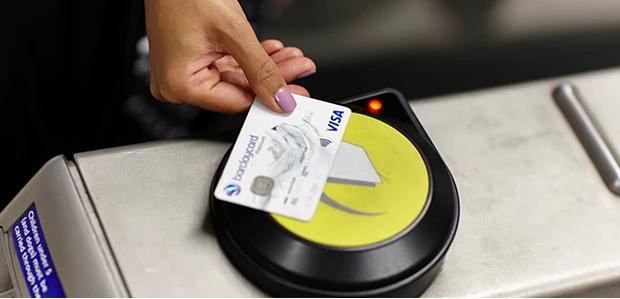
Since it was first introduced in 13 December 2012, more than 2.5 billion bus journeys have been made using pay as you go with a contactless bank card, mobile or smart watch. TfL’s world-leading contactless payment system now makes up around 70 per cent of pay as you go journeys on buses in London, according to the press release.
Transport for London (TfL) is marking ten years since contactless payment using a bank card was first introduced as a new way to pay on London’s buses, making it easier and more convenient for millions of customers.
The system, which evolved from TfL’s successful Oyster card system and was developed in partnership with the wider banking industry, allows customers to benefit from the ease and convenience of using their contactless bank card or mobile device, rather than having to pre-purchase anything. The system also allows for daily and weekly (Monday to Sunday) capping, meaning customers never pay more than the equivalent 7 Day ticket.
On its first day, only 2,061 customers made 2,586 bus journeys using contactless bank cards, although this was impressive given how few of the cards were in general circulation. Since then, the popularity of contactless, both as a means to pay generally and also as a method of paying for travel, has risen exponentially. A year after launching, TfL had seen more than 6.5 million journeys (around 33,000 bus journeys a day) being made using a contactless payment card and by December 2017, more than half a billion journeys had been made (with TfL seeing around 900,000 bus journeys a day made using contactless.)
Following the pandemic, bus ridership is now at around 80-85 per cent of pre-pandemic levels, with more than five million journeys a day being made – with around 1.7 million of those made using pay as you go with contactless. Around 70 per cent of all pay as you go journeys on buses are made using contactless payment cards or mobile devices – with the most popular bus route for contactless use the route 149 from London Bridge to Edmonton with around 100,000 contactless taps a week.
In September 2016, the introduction of the Mayor’s ‘Hopper’ fare, which offers unlimited bus and tram travel, within an hour of first touching in, for the price of a single fare, helped further increase contactless use. Since then, more than 770 million Hopper fare journeys have been made using contactless payment and Oyster cards on buses and trams across London.
TfL’s development of contactless payments is seen by many as the catalyst for contactless being adopted more generally by consumers across the world, as well as in the UK. The huge success of pay as you go with contactless in London has led to other cities across the world such as New York, Chicago and Sydney having now introduced contactless payment options for public transport based on London’s system.
_______________
London has now seen pay as you go journeys made using contactless cards or mobile devices from more than 180 countries across the world – demonstrating how easy it is for overseas visitors to arrive and travel using public transport without needing to buy a ticket.
130m contactless bank cards and mobile devices have now been used on Buses, Tube and Rail services since launch.
Pay as you go on buses and trams is £1.65 for adults, and customers can make unlimited journeys within one hour of touching in thanks to the Mayor’s Hopper fare. Pay as you go with contactless or Oyster also allows customers to take advantage of daily capping, which is £4.95 for bus and tram journeys only and cheaper than a One Day Bus and Tram Pass. Weekly (Monday to Sunday) capping is also available, set at £23.30 which is the same as a 7 Day Bus and Tram Pass.
Key milestones for contactless buses:
| 2012 | Contactless payment launched on the London Bus network on 13 December 2012 |
| 2013 | 10 April 2013 – one millionth journey made using contactless payment card |
| 10 June 2013 – two millionth journey made using contactless payment card | |
| 30 July 2013 – three millionth journey made using contactless payment card | |
| 14 September 2013 – four millionth journey made using contactless payment card | |
| 21 October 2013 – five millionth journey made using contactless payment card | |
| 23 November 2013 – six millionth journey made using contactless payment card | |
| 2014 | 16 September 2014 – Contactless payment card acceptance launched on the wider transport network |
| Weekly (Monday to Sunday) capping introduced for those using contactless payment | |
| 2016 | Mayor’s ‘Hopper’ fare introduced in September 2016, allowing customers to take a bus or tram journey and then change onto another bus or tram for free within one hour of touching in at the start of their journey |
| 2017 | More than one billion pay as you go journeys made by contactless payment cards on public transport in London |
| 2018 | Mayor’s Hopper fare expanded to allow unlimited journeys within an hour for the price of one on buses and trams in London |
| 2020 | Contactless payment was introduced on services to Reading, after being extended to Luton Airport Parkway and Welwyn Garden City in 2019. Together, these were the first extensions to pay as you with contactless only (so the extension did not include Oyster) |
| 2022 | Contactless journeys on buses now make up around 70 per cent of all pay as you go journeys, with around 1.7m journeys a day now made a bank card or mobile device |
Banking 4.0 – „how was the experience for you”
„To be honest I think that Sinaia, your conference, is much better then Davos.”
Many more interesting quotes in the video below: